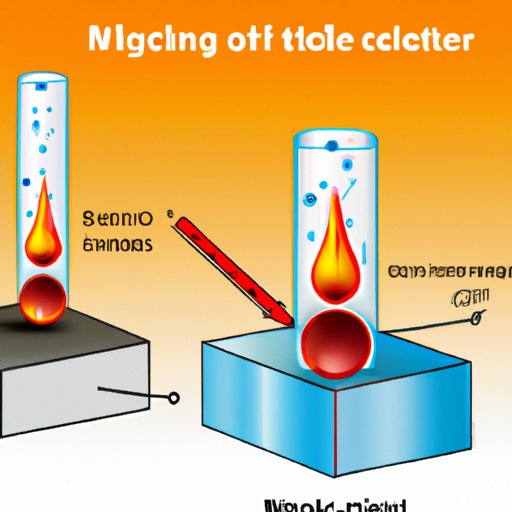Introduction
What is melting point? In simple terms, melting point is the temperature at which a solid material changes into a liquid. It is an important property of substances that can be used to identify and classify them. This article will explore the science behind melting point, from its definition and examples to its role in different areas of science.
Exploring the Science Behind Melting Point: An Overview
To better understand melting point in science, we must first define what it is. According to the Merriam-Webster Dictionary, melting point is “the temperature at which a substance passes from a solid to a liquid state.” In other words, it is the temperature at which a solid material undergoes a phase change from a solid to a liquid.
Melting point can be observed in everyday life. For instance, ice melts when heated, and wax melts when exposed to a flame. These are examples of melting point in action, as the materials have changed from their solid form to a liquid one due to an increase in temperature.
Understanding Melting Point in Chemistry and Physics
In chemistry and physics, melting point plays an important role in identifying and classifying substances. Every substance has a unique melting point, and this can be used to differentiate between substances and determine their chemical composition. For example, the melting point of water is 0°C, while the melting point of silver is 961.78°C. This information is useful for scientists as it allows them to easily distinguish between these two substances.
Chemical properties also influence melting point. Different types of bonds between atoms or molecules will affect the melting point of a substance. For instance, substances with strong intermolecular forces, such as hydrogen bonds, tend to have higher melting points than those with weaker intermolecular forces. Furthermore, the presence of certain functional groups can lower the melting point of a substance.
Physical factors also affect melting point. The size and shape of a particle can influence the amount of energy needed for it to melt. Additionally, the surface area of a particle can also play a role, as more surface area means more energy is needed for the particle to melt. Pressure can also affect melting point, as lower pressure typically results in lower melting points.

The Role of Temperature in Melting Point
Temperature is a key factor in melting point. As temperature increases, the kinetic energy of particles increases, resulting in the particles vibrating more rapidly and eventually breaking the intermolecular bonds that hold them together. Thus, the higher the temperature, the lower the melting point of a substance. However, this is not always the case, as some substances can have a lower melting point at higher temperatures due to other factors such as pressure or impurities.
How temperature affects melting point can vary depending on the type of material. For example, metals tend to have a linear relationship between temperature and melting point, meaning that as the temperature increases, so does the melting point. On the other hand, nonmetals often have a nonlinear relationship between temperature and melting point, meaning that the melting point may decrease as the temperature increases.

Investigating the Properties Affecting Melting Point
Pressure can also affect melting point. Generally speaking, lower pressures result in lower melting points, while higher pressures result in higher melting points. This is because at lower pressures, particles need less energy to break the intermolecular bonds, thus leading to a lower melting point. On the other hand, at higher pressures, particles require more energy to break the intermolecular bonds, resulting in a higher melting point.
Impurities can also affect melting point. Impurities can lower the melting point of a substance by weakening the intermolecular attractions between particles. Additionally, the presence of certain solutes can increase the melting point of a substance by increasing the strength of the intermolecular attractions.
Melting point can also be affected by alloys. Alloys are mixtures of two or more metals, and their melting points depend on the types of metals present in the mixture. For example, brass, which is a mixture of copper and zinc, has a melting point of 900°C, whereas pure copper has a melting point of 1084°C. Thus, the addition of zinc to the mixture lowers the melting point of the alloy.

Analyzing Melting Point in Everyday Life
Melting point plays an important role in many areas of science, from food science to metallurgy and engineering. In food science, melting point is used to determine the fat content of foods. For example, butter has a melting point of 35°C, while margarine has a melting point of 25°C. Thus, the lower melting point of margarine indicates that it has a higher fat content than butter.
In metallurgy, melting point is used to identify and classify metals. Metals with higher melting points are generally harder and stronger, while those with lower melting points are softer and more malleable. Furthermore, melting point can be used to determine the purity of metals, as impurities can lower the melting point of a metal.
In engineering, melting point is used to select materials for certain applications. For instance, materials with high melting points are ideal for use in high-temperature environments, while materials with low melting points are suitable for use in low-temperature environments. Additionally, melting point can be used to calculate the cooling rate of a material.
Conclusion
In summary, melting point is an important property of substances that can be used to identify and classify them. It is influenced by various factors, including chemical properties, physical factors, temperature, pressure, impurities, and alloys. Melting point has many practical applications in everyday life, from food science to metallurgy and engineering. Understanding the science behind melting point can help us make better decisions in our daily lives.
(Note: Is this article not meeting your expectations? Do you have knowledge or insights to share? Unlock new opportunities and expand your reach by joining our authors team. Click Registration to join us and share your expertise with our readers.)
